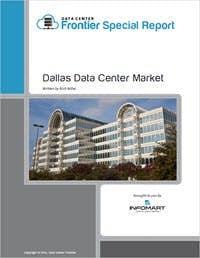We continue our series of stories on the leading geographic markets for data center space. Data Center Frontier is partnering with DatacenterHawk to provide in-depth market reports on each city we profile.
The Dallas/Fort Worth region is poised for a data center building boom, with more than 200 megawatts of potential capacity in the pipeline. Already one of the largest and most active data center markets in the United States, Dallas market is benefiting from a confluence of site selection merits: excellent power and fiber infrastructure, competitive economic incentives and robust competition among service providers.
Data Center Frontier Special Report: The Dallas Data Center Market. Download It Now.
Dallas is notable for the diversity of its data center ecosystem, with strong demand for retail colocation, wholesale data center space, powered shell and build-to-suit projects. The market is boosted by its location in the center of the country, and sees demand for space from multiple business verticals, including hosting and cloud players as well as enterprise customers in finance and energy.
The Dallas area is home to 2.5 million square feet (SF) of commissioned data center space, representing 278 megawatts (MW) of commissioned power, according to market research from datacenterHawk. That makes Dallas the third-largest market for data center space in the U.S., trailing only Northern Virginia and Silicon Valley. Demand for space is fairly strong, as reflected in the vacancy rate of 12.2 percent in the region.
The region’s data center capacity is spread across several sub-markets, including major carrier hotels in downtown Dallas, a cluster of facilities near Love Field to the West, a nexus of wholesale data centers in the “Telecom Corridor” in Richardson, and an emerging market further north in Plano.
Over the past two years, the Dallas market has emerged as a focus of significant investment by leading players in the data center industry. This includes new ownership and strategic focus impacting the major carrier hotels in downtown Dallas, the entry of at least four new players in Dallas suburbs, and significant expansions by existing providers.
What’s Hot About Dallas?
The Dallas/Fort Worth (DFW) data center market has grown steadily over the past five years. Demand in this market often originates from companies with a large presence in the area. However, many companies outside the area find the Dallas market appealing, due to five key attributes:
- 1. Favorable Business Environment – DFW is home to over 100,000 businesses, with an economy that expanded 5.7% last year (the seventh best in the United States).
- 2. Competitive Colocation/Cloud Ecosystem – A large number of qualified operators deliver facilities, services, and expertise to the many companies in the region who outsource their information technology (IT) infrastructure.
- 3. Reasonable Power Cost – Compared to other primary data center markets, electricity in the DFW area is relatively inexpensive.
- 4. Robust Infrastructure – The region’s electrical and telecommunications infrastructure is both dense and diverse.
- 5. Tax Abatement Incentives – The State of Texas passed legislation in 2013 to grant tax breaks for large colocation and enterprise users.
Over the last three years, Dallas/Fort Worth has drawn large corporate relocations. Most companies go to Texas due to the state’s central location, affordable real estate prices, and good tax incentives. The Dallas area in particular has a diversified labor force, with strong growth recently from the technology and services industries.
In August 2015, the DFW market created jobs at a 2.1% rate which is better than the rest of the state (1.1%) and the United States overall (1.8%), according to data from the Federal Reserve Bank of Dallas. In addition, the Dallas market’s unemployment rate is currently 3.7% and has been steadily declining since 2009.
Background & History
The early growth of DFW’s data center market was focused in downtown Dallas. Because the central business district is rich in telecommunication infrastructure, several large office buildings were retrofit for data center use, most prominently the Infomart Dallas, and 2323 Bryan Street. These buildings typically attract smaller colocation customers, along with telecommunications companies.
A data center at Digital Realty’s campus. in Richardson, Texas (Image: Digital Realty)
As the colocation market grew significantly in 2009 and 2010, these companies expanded beyond downtown. An obvious expansion route was the northern suburbs of Dallas, which boomed during the 1990s when the “Telecom Corridor” attracted dozens of leading companies in the telecom, software and semiconductor sectors. This area was hit hard during the dot-bust of 2001-03, but has seen a new round of growth as Dallas has emerged as a hotbed for hosting and colocation.
Cities like Richardson, Plano, Far North Dallas, and Carrollton benefited from the growth by offering sites and buildings with expansion opportunities. In addition, most colocation providers in the DFW market are choosing to construct new facilities instead of retrofitting existing buildings worthy of conversion.
For more on the Dallas market, we invite you to download the Data Center Frontier Special Report: The Dallas Data Center Market.
And for further coverage, check out Data Center Frontier’s page dedicated to the Dallas Data Center Market, that will provide the latest stats and info on this quickly growing area that is continuing to experience a data center boom.
About the Author





